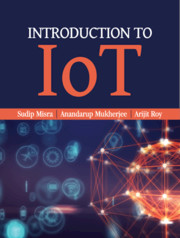Conceptual Questions
Published online by Cambridge University Press: 09 January 2021
Summary
Introduction
This portion of the book spans the contents of the entire book. It is designed to provide readers with an idea about the various concepts required for utilizing IoT in real life. We present, here, various conceptual questions, which one comes across in real life; they can be answered using the concepts, protocols, and methodologies covered in the previous chapters of this book. This portion also provides an informal guideline for teachers and instructors to formulate questions relating to IoT and its technologies.
The questions provided in here are significantly different from the ones covered at the end of each chapter. They require the reader to delve deeper into the concepts and fundamentals of the covered technologies, which will require some effort on the reader's part. At times, the readers will have to consult other books, online resources, and materials. This exercise will enable them to explore, beyond the introductory level, the various concepts covered in this book.
Questions
Q1 What are the roles of end-users and the service provider in cloud computing?
Q2 What is a hypervisor?
Q3 Let there be a task of 480 TB from a host machine that needs to be processed in the cloud. The service provider has three data centers (DC), DC1, DC2, and DC3, which are capable of processing the task. The following table describes the capacity of different data centers: To which of the DCs do you think it best to allocate the task? Justify your answer.
Q4 Let there be four fog nodes F1, F2, F3, and F4, connected with several IoT devices. The data generated from the IoT devices can be processed either in single or multiple fog nodes. The fog nodes, F1, F2, F3, and F4, can accommodate up to 20 GB, 90 GB, 28 GB, and 46 GB respectively. Further, these fog nodes, F1, F2, F3, and F4 take 12 μs; 18 μs; 28 μs and 22 μs to complete 10 GB of task. A cloud architecture is also available to execute different tasks; it can process 20 GB of task in 8 μs. An IoT device requires to process 246 GB of data. The time taken to transmit data packets to the cloud is longer than the time taken to transmit data packets to fog nodes. However, the device is associated with a critical application.
- Type
- Chapter
- Information
- Introduction to IoT , pp. 375 - 387Publisher: Cambridge University PressPrint publication year: 2021

